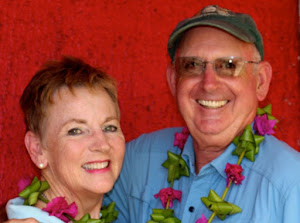Friday, February 5, 2016, Worrall Travel R Day (WTRD) 28
Today, we have nothing special on our agenda. There is a small golf course associated with a hotel in town that we might check out, a natural history museum, and also we would like to return to the bird preserve. The skies are clear and the temperature is warming up to upper 70's. We need to turn our rental car in tomorrow, so we plan to gas it up early, as we will not be driving after this afternoon.
Since the town is small, we thought we should get our gas first. The stations are government owned, and there are two of them, one on each end of town. These are mega stations that serve tourists and commercial vehicles (tour busses) that travel the length of Patagonia. The first station only had diesel and it looked liked their regular gas pumps were being repaired, so we could not get gas there. Next we traveled across the little town to the station on the other side. We could not believe our eyes; the queue into the station was not moving and several miles long! Well, we would try again later.
We checked in with the Spa that operates the golf course. Yes, the course was open to the public not just the hotel guests; we could rent golf clubs. This course is an 18 hole, par 3 course on perhaps two acres of land. How is that possible? There are only 6 holes, but 9 tee boxes. The golf manager drew lines on our course map to show how we would zigzag around. We could play 18 holes if we wanted, but we weren't eager to play more than 9 as we knew we would be spending most of our time figuring out where to go.
Originally, Russ wanted to play on Saturday. But today, we would be the only ones on this little course. Tomorrow there were six filled tee times starting at noon. If you look at the map and the way the balls fly from every direction through the middle section (the death circle) and my history of being hit in the head by an errant tee off, you can imagine my reluctance to want to be on a course like this with other players. So we opted to play on Friday, right there and then, skipping lunch and settling for an apple and a couple of granola bars.
We spent a couple of hours on "our private" and challenging little course, having a great time.
After our game, we went to the Natural History Museum and spent a couple of hours learning more about the geology, dinosaurs, ice age, and indigenous people of Argentina. It was very interesting.
 |
| My head is as big as his eyeball. This dinos were gigantic. |
By now, we were parched and hungry, so we headed back to a little cafe across from the bird preserve, where we drank a bottle of wine and ate empanadas (little meat and cheese pies). We asked our waiter what was going on with the gas stations in town. Apparently, there is a blockade "workers strike??" on the roads coming into town preventing the gas trucks. Yipes! What a nightmare. Glad we aren't traveling north on Route 40 anytime soon.
After our dinner, we took another 3 kilometer walk through the bird preserve. The weather was so warm and the air so still, most of the birds must have been hiding. We saw few compared to the first day, but never the less enjoyed the walk.
Before we returned to the hotel, we tried again to get gas. No luck, no gas. The queue was longer, and I think people were starting to camp in line. We returned back to our BNB and got ourselves packed up, as we change accommodations in preparation for our Patagonia Adventure Tour. Lights out at midnight!.
Saturday, February 6, 2009, WRTD 29
We bid farewell to our wonderful hosts, brother and sister team Javiar and Andrea, at South BnB. By 10:00 am we are on the road, we deposit our bags at the new hotel, and check out the gas station situation before returning the car. One station is still not working, the other the queue goes on for as far as the eye can see. Cars are in line, locked, and vacated. People must have gone home for the night, or are taking turns sitting in the family car waiting. We give up, bite the bullet, and return the car with a half full tank, and pay $50.00.
We enjoy one last day walking around town, shopping, eating at a cafe, returning to our new hotel to relax, read, and nap.
Tonight we met our group on the Patagonia Adventure tour. Their are 8 of us walkers, and our tour leader. We leave tomorrow morning for the Pietro Moreno Glacier.
































































